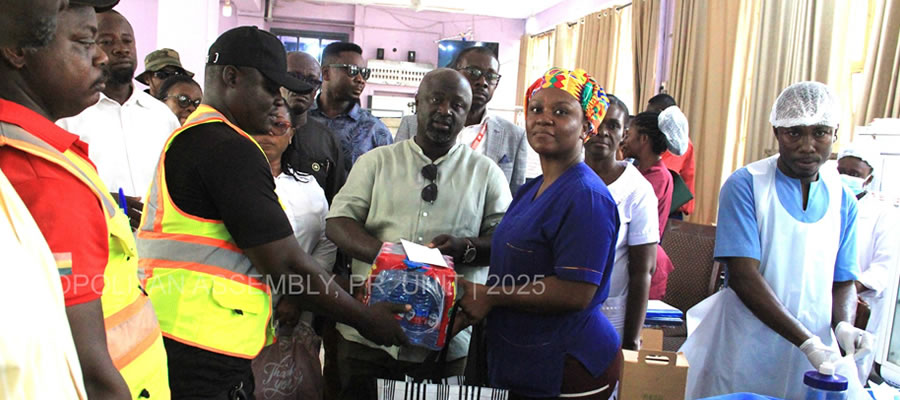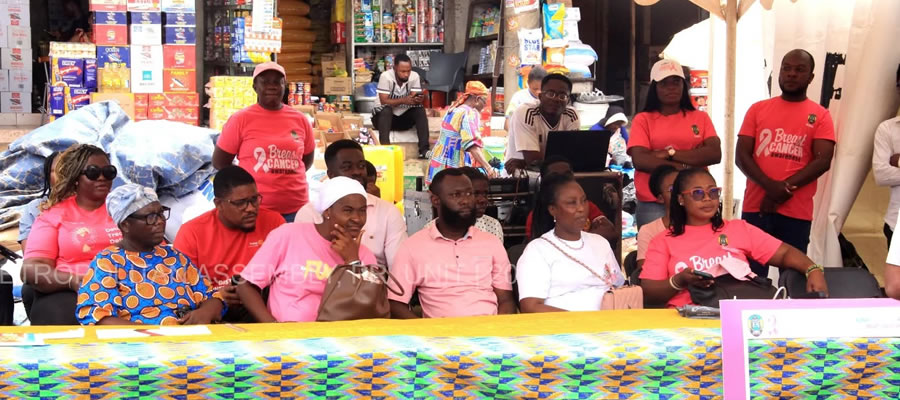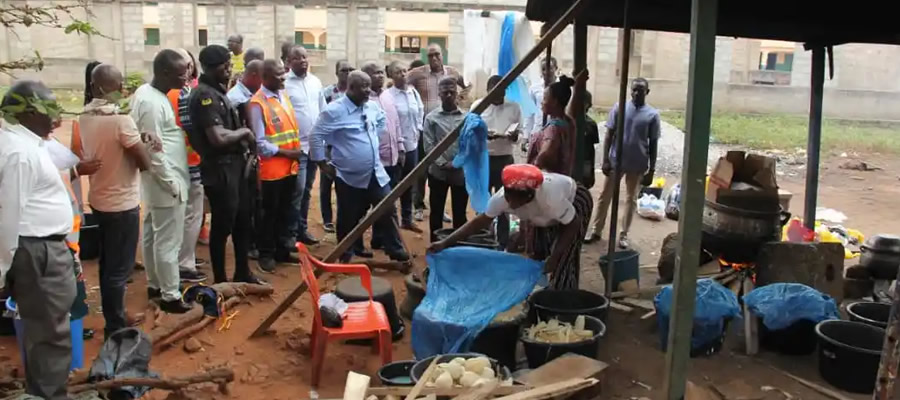

Culture and Ethnic Composition
The Traditional Set Up
Culture as the totality of the way of life evolved by a people through experience and a reflection in an attempt to fashion a harmonious co-existence with the environment has made the city of Kumasi the citadel of Ghana’s rich cultural heritage.
The Asantehene is the embodiment of the culture of the people. He presides over the other paramount chiefs in the Ashanti Region. The virtues in the traditional set-up are aptly demonstrated in the family system and the chieftaincy institutions. Even though there are other cultures they have been eclipsed as they are in the minority.
The line of inheritance or succession in the Akan culture, for that matter the indigenes, is matrilineal. Each family unit is headed and controlled by the Abusuapanin and Obaapanin who always ensure that the family is in perpetual peace and harmony. Where there is a problem among members of the same family, the two elders of the family assisted by other members of the same family will resolve the impasse. This system operates in every family and it goes up to the larger community where there are chiefs, queen mothers and elders, who apart from being spiritual heads of the larger community, are responsible for the welfare and well being of everybody.
Ethnic Diversity
Although the Kumasi Metropolis is Asante dominated, almost all the other ethnic groups in Ghana are represented. Ethnic and cultural diversity abounds tremendously in the metropolis, but they are closely – knit together in a harmonious relationship.
The diverse ethnic groups in the area can be attributed to the following factors;
The rate of in migration into the metropolis as a result of its strategic location and also rapid urbanization.
The ability of these diverse ethnic groups to co- exists with each other and share cultural values.
Presence of a strong traditional administrative set-up that galvanizes cohesion among the diverse ethnic groups.
Communal Spirit
In spite of the diversity in ethnicity, there is a high sense of communal spirit amongst the people. The belief systems make the people cherish who they are and make it easier to see themselves as one people despite their differences. This is demonstrated in the numerous clean-up exercises carried out in the metropolis. There is also local enthusiasm in project planning and implementation.
Traditional Knowledge
The traditional beliefs and knowledge of our people are largely rooted in every aspect of their livelihood. These values in our traditional set-up are aptly demonstrated in our family system, chieftaincy institutions and superstitions or beliefs. Traditional knowledge is rooted in music, folktales, drumming and dancing, carvings and proverbs. These have been carried over from generation to generation. These are visible during festivals, durbars and funerals and have made the people of Kumasi in particular and Ashanti in general to maintain the purity and tapestry of their culture.
Attitude and Practices
Culture as the totality of the way of life evolved by people through experience is a reflection of the attitude and practices of the people. The rich cultural heritage of the people of Kumasi is visible in Akwasidae festival, funerals, child-naming ceremonies, communal spirit and religion. The traditional religious practices are still upheld through the pouring of libation, marriage rites and rites of passage.
For instance, the Akan word ‘Akwaaba’ is commonly expressed or said to welcome strangers and visitors in our midst. This expresses the hospitable nature of the people. Attitudinally, the Akan culture stresses the importance of according respect to the elderly. Support is also extended through the extended family system.
Participation
The traditional political system and the family structures have combined effectively to promote participation. The Chief sitting in state with his Elders make decisions that are binding on all. However, as a result of urban morphology Kumasi is fast losing this value to the modern traditional administrative set-up.
The diversity in ethnicity therefore does not erode popular participation in decision- making, the chiefs being the rallying points. In Asante Culture the death of a person is seen as a blow to the entire community and everybody shares the grief. This is demonstrated during funeral celebrations, illness and disaster. Festivals also serve as platforms for the community to address petty squabbles and plan for the development of the community. Participation is also vivid during elections whether local (District Assembly) or National elections.
Positive Cultural Practices
The positive cultural practices as an epitome of the rich cultural heritage of the metropolis are visible in the Akwasidae Festival, funerals and Chieftaincy institution and the traditional craftsmanship in the areas of the world’s famous Kente Cloth, pottery making and brass smithing.
Kumasi has been recognized as a focal point of international visitor interest. By way of international visitor arrivals, it is estimated that 50% of tourists visiting Ghana make it a point to see the treasures of the city and its environs. The Akwasidae Festival attracts people from all walks of life, especially those in the Diaspora. This brings in some limited income to those who deal in traditional wares eg. kente, woodcarvings. All these are potential sources of foreign exchange earning in view of the international visitor interest in this rich cultural heritage. Funerals and child naming ceremonies are occasions for settling amicably individual and family squabbles.
Negative Cultural Practices
The issue of negative cultural practices smack debate. The issue of cultural relativity comes to mind. Most of the things that are today considered negative were relevant and justifiable at the time. However, practices such as puberty and widowhood rites, which were aspects of Asante Culture, are no longer in practice in the metropolis.
Implications for Development
The annual population growth rate in the metropolis has serious implications for development.
The existence of a large market. The large population size coupled with the high growth rate of 5.47% engenders an increase in aggregate demand.
An enabling atmosphere exists to foster the rapid development of forward and backward linkages between industry and agriculture (urban – rural production linkages.)
The structure of the population of the metropolis reveals that of a growing population. This type of population phenomenon is characterized by what Michael Todaro termed as the “hidden momentum” which has the propensity to trigger off a population explosion. This, in the final analysis, exerts pressure on the existing facilities and further compounds the need for rapid expansion in the infrastructural base e.g energy, roads, schools, health care and housing.
There is the need for more concerted effort on the part of Government and other stakeholders at developing pragmatic programmes with far reaching outcomes to address the rural- urban drift. A more frontal attack on poverty and all its ramifications is what are required.
Religious Composition
Christianity is the dominant religion in the metropolis. The proportions of the population in the metropolis in terms of religion are 78.8%, 16.0%, 0.3% and 0.7% for Christianity, Islam and Traditional and Others respectively. Apart from these four groupings, there is this other group with “No Religion” which constitutes about 4.2% but could vary.
Tourism Attractions
Rich unadulterated culture is up for tourists viewing in Kumasi and for this, the metropolis has gained much recognition. This is visible from royal Akwasidae Festivals to fetish rituals and even to everyday ceremonies. Kumasi metropolis also has several unique tourist attractions. One is the Centre for National Culture, which helps to promote, preserve and protect Ghana’s culture.
It provides facilities for recreation and opportunities for study and research in the arts and craft industry in Ghana. The famous Golden Stool, which was conjured from the sky by Okomfo Anokye, which today forms the symbol of the Ashanti nation and the collective soul of the Ashanti tribe, is housed at the Manhyia Palace. The Palace is itself a major tourist attraction, being the residence and court of the Asantehene, King of Ashanti.
Okomfo Anokye’s Sword is behind the Teaching Hospital named after him and is said to be immovable. The Bantama Royal Mausoleum is where the bodies of Ashanti kings were preserved until the late 1850s.Non-members of the royal family cannot enter the mausoleum. There is also the Kumasi Fort and Military Museum, which exhibits relics of Ashanti wars, the two World Wars and Ghana’s recent military history.
For nature lovers, there is the Kumasi Zoo, adjacent to the Cultural Centre, and has on display reptiles, lions, elephants, birds and primates. The metropolis has hotel facilities that cater for all groups of people from budget hotels to those of international standards.
Information on Kumasi Zoological Gardens
History
Kumasi Zoological Gardens (Kumasi Zoo) was opened as a result of a decision taken in July 1951 by the Asanteman Council to preserve Ashanti culture, foster social research and publish journal notes on Ashanti customs and other matters of general interest.
The Zoo was officially opened in 1957 with the purpose of displaying indigenous wild animals of Ghana in captivity (including free roaming Pea-fowls) with the view to demonstrating the linkage between wildlife and culture and thereby emphasising the need for wildlife conservation.
The Zoo was managed at different times by the then Kumasi Municipal Council and the Forestry Department and since 1974 managed by the Wildlife Division of the Forestry Commission
(formerly Department of Game and Wildlife).
Overall Functions of Wildlife Division
Protect, manage and develop wildlife resources in the national interest and regulate the harvesting of wildlife resources. Vet the export of wildlife products, conduct pre-shipment inspection, examination of wildlife products. Develop and promote the economic potential of wildlife through eco-tourism and sustainable exploitation of wild plants and animals, including their by-products.
Develop the wildlife management capacity at the national, district and community levels including stakeholder participation of the effective management of wildlife within and outside the protected areas. Promote public awareness, understanding and support for wildlife conservation, facilitate continuous improvement in wildlife management through research.
Functions of Kumasi Zoo
The functions of the Zoo are to:
1. Display local fauna in captivity to satisfy the curiosity of the viewing public.
2. Conduct Conservation Education with the aim of educating the public about wild animals especially the rare and disappearing (endangered) ones.
3. Conduct scientific research into various aspects of wildlife biology, ecology etc.
4. Engage in the breeding of endangered species.
5. Offer a sanctuary for orphaned animals.
6. Generate revenue.
7. Offer a place for relaxation and recreation for the leisure time visitor.
Location
The Kumasi Zoo occupies a prime site in the centre of Kumasi, providing one of the few green urban areas in Kumasi for both local citizens and visitors. It is situated in Kejetia, a suburb of the central business area of the Kumasi Metropolitan Area and is located between 6° 34’ N - 6° 46’ N and 1°30’ W - 1°44’ W of Ghana.
Area
It occupies an area of about 11 ha and is completely walled.
Landscape
Forest and marshland with centrally flowing stream of high cultural significance to the people of Ashanti.
Zoological Collection
Mainly local fauna comprising of the following:
Carnivores (Big & Small Cats) Six (6) Species
Primates Nine (9) Species
Rodents, Five (5) Species
Reptiles Thirteen, (13) Species
Ungulates Six (6) Species
Birds Eighteen (18) Species
Tourism in Kumasi has taken a different path now, compared to the past when Queen Elizabeth visited the city of Kumasi in 1961; she named Kumasi “The Garden City of West Africa” because of its flora and beauty. It has been estimated that 50 per cent of tourists who visit the country visit Kumasi. The city has an outstanding rich cultural heritage, which is depicted in festivals, like the Akwasidae, funerals and child naming ceremonies. These basically attract tourists worldwide and if well promoted would help to improve tourism in the city.
Current Situation
The current situation is that, some of these tourist attractions that were once highly patronised are not so functional due to underutilization, poor maintenance, outmoded materials/equipment and little publications of these sites.
Tourist Attractions
There is no doubt that Kumasi, and for that matter the Ashanti Region, constitutes the very core of the cultural and tourism heartbeat of Ghana. Visitors and tourists to the capital of the Golden Kingdom of Ashanti are always pleasantly surprised by the hospitality of the people. In fact, according to some tourists, a visit to Ghana is incomplete without a visit to Kumasi.
What will equally strike visitors is the people’s manifestation of the rich Ashanti culture magnificently demonstrated in their language, customary rites, festivals, cuisine and vivacious mannerisms.
Manhyia Palace
It is the seat or palace of the Ashanti King, which dates back to the 17th Century. It also houses a Royal Museum stocked with rare and u nique royal paraphernalia and life-size effigies of notable Ashanti Kings and Queens.
The palace also hosts the ever-popular Akwasidae Festival held every six weeks in accordance with the Ashanti traditional calendar.
Centre for National Culture
The Cultural Centre, the first of its kind to be established in Sub-Saharan Africa in 1952 features the following:
Prempeh II Museum – (This museum principally showcases the rich history and culture of the Ashanti Kingdom.
Craft Centre – (Traditional craftsmen can be observed here displaying their skills in the weaving of the world famous kente cloth, pottery and brass smithing)
A Gift Shop – (The centre has a number of gift shops where Ashanti traditional textiles, leatherworks, carvings and other Ghanaian artifacts may be bought).
Cultural Displays and Tutorials – (Traditional dances and performances can be observed or taught for a fee on request)
Other places of interest include the following:
- Okomfo Anokye Sword
- Fort St. George (War Museum)
- Kumasi Central Market
- Kumasi Zoological Gardens
Hotels
Hotel Infrastructure
There are a number of hotels, restaurants and traditional catering facilities with a wide variety of menu both continental and local dishes).
Travel and Tour Agencies as well as tour guides exist to provide auxiliary services. The importance of this sub-sector to the metropolitan economy cannot therefore be overstated. It has the potential to contribute immensely to its growth in terms of revenue generation and employment creation.
Date Created : 11/27/2017 8:04:07 AM












 facebook
facebook
 twitter
twitter
 Youtube
Youtube
 +233 593 831 280
+233 593 831 280 0800 430 430
0800 430 430 GPS: GE-231-4383
GPS: GE-231-4383 info@ghanadistricts.com
info@ghanadistricts.com Box GP1044, Accra, Ghana
Box GP1044, Accra, Ghana